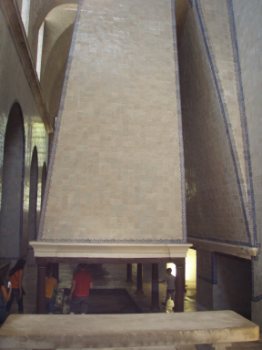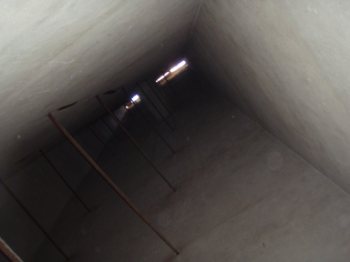Alcobaça Monastery
After a really nice lunch in Batalha, Ann
(Ann and Michael - Nimue) once again took charge of getting us on the right bus
to visit the amazing Mosteiro de Santa Maria de Alcobaça.
A mediaeval monastery located in
the town of Alcobaca, in central Portugal. It was founded by the first
Portuguese King, Afonso Henriques, in 1153, and maintained a close association
with the Kings of Portugal throughout its history.The church and monastery were
the first Gothic buildings in Portugal, and, together with the Monastery of
Santa Cruz in Coimbra, it was one of the most important of the mediaeval
monasteries in Portugal. Due to its artistic and historical importance, it was
listed by UNESCO as a World Heritage Site in 1985.

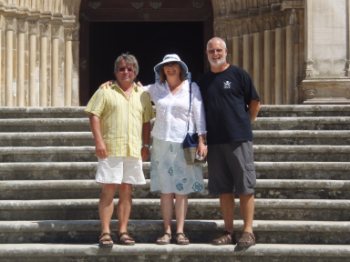

View of the outside, Michael, Ann and Bear on the steps. Ann read out the
pamphlet (so well) as we trotted round, with THAT HAT, we had to fight off a
whole coach load of Americans who thought "tour guide" was her day job. The
length of the chapel was awesome.
The Alcobaça Monastery is one of the
first foundations of the Order of Cistercians in Portugal. It was founded
in 1153 as a gift to Bernard of Clairvaux, shortly before his death,
from King Afonso, to commemorate his victory over the Moors at Santarem in
March 1147. The foundation of the monastery was part of the strategy by
Afonso to consolidate his authority in the new kingdom and promote the
colonisation of areas recently taken from Moorish hands during the
Reconquista.
Ann doing the readings from the pulpit over the
refectory, Ann's Chimney as it is now known. She was so amazed, having read the
bumph that we had to find it - the monks could roast 6 oxen at one time.
This weeks mysery shot.
The building of the monastery began in 1178, some 25 years
after the arrival of the Cistercian monks in the Alcobaca region. Initially, the
monks lived in wooden houses, and only moved to the new stone monastery
buildings in 1223. The church was completed in 1252. The finished church and
monastery were the first truly Gothic buildings in Portugal, and the church was
the largest in Portugal. The last touch in the mediaeval ensemble was given in
the late 13th century, when King Dinis I ordered the construction of the
Gothic Cloister of Silence. The monks led no outside ministry and
lived in complete silence with prayer/companionship. The abolition of the
religious orders in 1834, following the victory of the liberal troops, led to
the monks abandoning the monastery after a seven century stay.
The monks dedicated their lives to religious meditation,
creating illuminated manuscripts in a scriptorium. These monks produced an
early authoritative history on Portugal in a series of books. The library at
Alcobaça was one of the largest Portuguese mediaeval libraries, but was pillaged
by the invading French in 1810 and again in 1834 by the anti-clerics. The
remnants of the monastery library, including hundreds of mediaeval manuscripts,
are kept today in the National Library in Lisbon.



The Royal Hall, some had lost their heads, there were blank plinths for
kings of the future. The Abbot's room, this vast area for one
man? The huge cloister was stunning. Again made me ask "Do they take women".
During the Middle Ages, the monastery quickly became an
important and powerful presence in Portugal. The monastery owned and developed
extensive agriculture areas, and the abbot exerted influence over a large area.
A public school was opened in 1269. The importance of the monastery can be
measured by the fact that many royals were buried here in the 13th and 14th
centuries. Kings Afonso II and III and their Queens Urraca of Castile and
Beatrix of Castile are buried here, as well as King Pedro I and his mistress,
Ines de Castro, who was murdered on the orders of Pedro's father, King Afonso
IV. After being crowned King, Pedro commissioned two magnificent Gothic tombs
for him and his mistress, both of which can still be seen inside the monastery
church. (on opposite sides of the building to keep them apart).


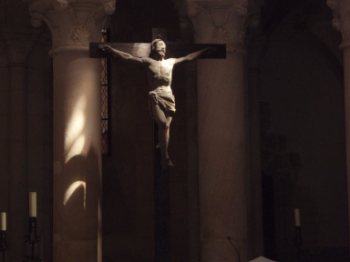
The recumbent figure of Pedro I and far away his mistress. Just caught the
light perfectly to best show the Crucifix.
During the reign of Manuel I, a second floor was added to the
cloister and a new sacristy was built, following the characteristic Portuguese
late Gothic known as "Manueline". The monastery was further enlarged in the 18th
century, with the addition of a new cloister and towers to the church, although
the mediaeval structure was mostly preserved. In the Baroque period, the monks
were famous for their clay sculptures, many of them are still inside the
monastery. Elaborate tiles and altarpieces completed the decoration of the
church.



Whilst Ann was busy with her camera, Michael and Bear took the opportunity to
do a bit of the commentary, soon taken back by our rightful leader. Bear by the
symbolic bath, we didn't expect the goldfish !!!!
The great 1755 Lisbon Earthquake did not cause significant
damage to the monastery, although part of the sacristy and some smaller
buildings were destroyed. Greater damage was caused by invading French troops in
the 1800s. In addition to looting the library, they robbed the tombs, and stole
and burnt part of the inner decoration of the church.
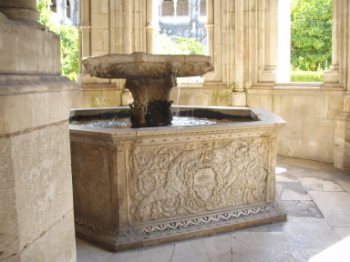


The Renaissance fountain, a statue of St Theresa, just for you,
Theresa, we are still looking for St Bernard but did find his Wing. Bear sussing
out the sundial.

Today, the Monastery is one of the main historic tourist
destinations in Portugal and not to be missed, we were so impressed and much
preferred it to Batalha. Ann now has the official title PATHFINDER aka
PF.





